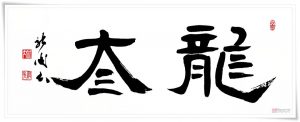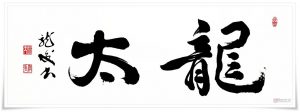Calligraphy is present in everyday life in the Far East. It is seen on streets, in newspapers, on the menus of local restaurants, gift wrappings, and so on, yet we usually pass by without noticing it. There is, however, one instance when the magic of ink embraces our days, and we slow down and take a few moments for quiet appreciation.
Possibly the most touching and significant way in which the Asian community comes into contact with calligraphy in modern times is the birth of a child and the ceremony of name giving. In Japan it is known as shichiya (七夜, しちや, lit. “seventh night”). According to an old Japanese tradition, on the seventh night after a child is born, parents get to choose a name for their little ankle biter. Once the name is chosen they go to a nearby Shinto shrine and decorate it with a piece of paper on which the child’s name is written. Then they pray, asking for blessings (though, naturally, it depends on the condition of the infant and his mother) in the child’s name. The foundation for this custom was laid. in times past when the mortality of young infants a few days after birth was quite high. It is customary for a calligrapher to write the name of the infant, although parents can do it themselves. If the family has no calligraphers amongst them, they will most likely make a request to someone who is skilled in this art and has the trust and respect of both parents. To receive such a request is a great honour for the calligrapher.
Figure 2. Writing calligraphy works shown in Figures 3 and 4.
As with nearly everything in Japanese culture, there is a proper etiquette for writing a child’s name. First, the characters of the infant’s name ought to be large and placed in the middle of the calligraphy paper. Then, the words 命名 (めいめい, meimei, i.e. “naming” as ) should appear at the top, the birth date at the left and the parents’ (also siblings’) names on the right-hand side of the child’s name. It is also customary to use washi (和紙, わし, i.e. ”Japanese paper”) made of mulberry pulp.

This is the 4th time I have been asked to write a child’s name calligraphy in Japan. A baby boy was born to a dear friend of mine, Dave Gosine, the founder of the Beyond Calligraphy project. He was born three weeks ahead of his due date, on the 31st of December, 2011, and currently is screaming his way into the Year of the Dragon, driving both parents bananas, though they claim that they are enjoying it. His name is Ryūta (龍太, りゅうた).
My approach to writing a child’s name differs from the traditional one, as both Dave and I are not too crazy about following rules. Also, written this way, it serves as a stand-alone calligraphy work as well.

I prepared two works, one in clerical script (隷書, れいしょ, reisho), and another in semi-cursive script (行書, ぎょうしょ, gyōsho). They differ from one another greatly. My idea was to show two different natures of a newborn child. The semi-cursive script calligraphy is a tribute to an adventurous rumbling cracker, a life rocket with a short fuse continuously moving about, curious of his surroundings. The other is dedicated to a more dignified young man, approaching life with reserve and a smidge of pondering before acting. Come to think of that, it is possible that I could benefit from such a trait, too. In short, the image of a scholar on roller skates would be apropos. Oh, but calligraphy is just like that. You need to be serious about your studies, but you ought to remember to have fun, too, just like a kid.
